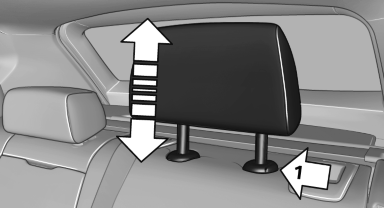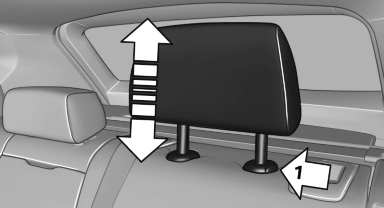Rear head restraints
Correctly adjusted head restraint
A correctly adjusted head restraint reduces the risk of injury to cervical vertebrae in the event of an accident.
![]() Adjusting the head restraint
Adjusting the head restraint
Correctly adjust the head restraints of all
occupied seats; otherwise, there is an increased
risk of injury in an accident.◄
Height
Adjust the head restraint so that its center is approximately at ear level.
Adjusting the height

► To raise: pull.
► To lower: press the button, arrow 1, and
push the head restraint down.
The center head restraint cannot be adjusted in elevation.
Removing
Only remove the head restraint if no one will be sitting in the seat in question.

1. Pull the head restraint upward as far as possible.
2. Press the button, arrow 1, and pull the head
restraint out completely.
![]() Before transporting passengers
Before transporting passengers
Reinstall the head restraint before transporting
anyone in the seat; otherwise, the protective
function of the head restraint is unavailable.◄
See also:
Status of this Owner's Manual at time of printing
BMW pursues a policy of continuous, ongoing development that is conceived to
ensure that our vehicles continue to embody the highest quality and safety standards
combined with advanced, state-of-t ...
Gentleman function
The front passenger seat can be adjusted with
the switches of the driver's seat.
1. Press the button. The LED
lights up.
2. Adjust the front passenger seat on your own
seat.
3. If needed, ...
Applying
The lever automatically engages after being
pulled up. ...
